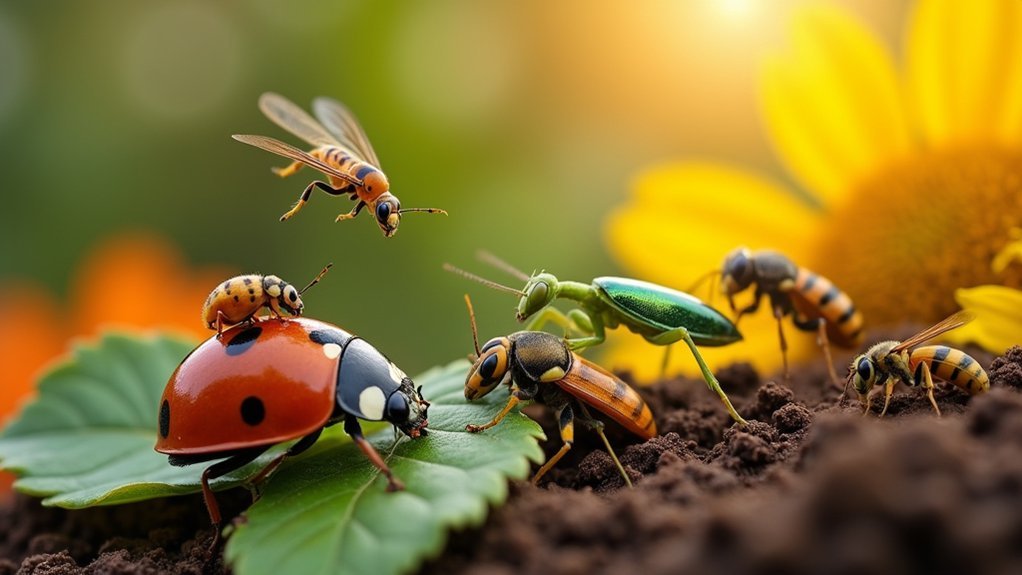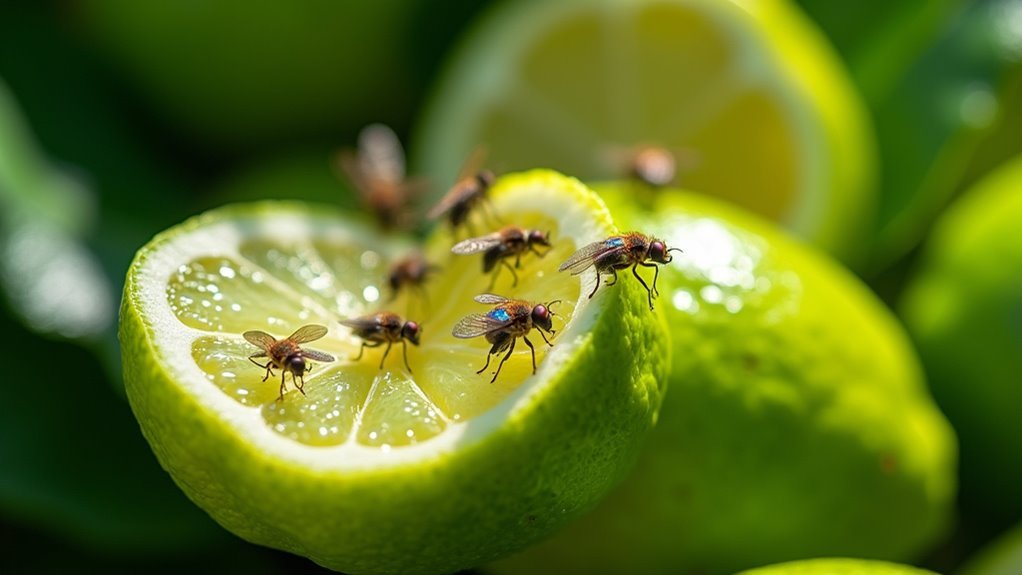Have you ever watched a tiny ladybug devour dozens of aphids from your cherished roses? Nature’s pest control squad works silently but effectively in your garden, offering a chemical-free solution to your pest problems. You don’t need to douse your plants in harsh pesticides when these beneficial insects can do the job better. From the voracious appetite of lacewings to the surgical precision of parasitic wasps, these five natural predators will transform how you approach garden protection forever.
Wondercide Natural Outdoor Pest Control Spray (32 oz)
Environmentally conscious homeowners seeking a non-toxic approach to pest management will find Wondercide’s plant-powered formula strikes an effective balance between pest control and ecosystem preservation. This hose-attachment spray covers up to 5,000 square feet, repelling mosquitoes, ants, ticks, and other pests while sparing beneficial insects.
You’ll appreciate its safety around children and pets, but understand its limitations—it’s more repellent than exterminator. For ideal results, combine with other control methods like traps. The effects are temporary, especially after rain, requiring regular reapplication. While this impacts cost-effectiveness, many users value the trade-off for a chemical-free yard.
Best For: Environmentally conscious homeowners who prioritize natural pest control methods and are willing to reapply frequently for a chemical-free yard experience.
Pros:
- Safe for use around children, pets, and beneficial insects like bees and butterflies
- Easy application with hose attachment covering up to 5,000 square feet
- Made from plant-powered, biodegradable ingredients with a pleasant scent
Cons:
- Requires frequent reapplication, especially after rain, which increases long-term cost
- Functions more as a temporary repellent than a complete pest elimination solution
- Works best when combined with other pest control methods for comprehensive protection
Mighty Mint Peppermint Bug Control Natural Lawn Spray (32oz)
Homeowners seeking a natural, chemical-free approach to pest management will find Mighty Mint Peppermint Bug Control an appealing alternative. This US-farmed peppermint solution covers up to 6,100 square feet, targeting fleas, ticks, mosquitoes, and ants while remaining safe for pets and people.
For best results, apply during evening hours and reapply weekly, especially in sunny areas. Users praise its pleasant aroma that freshens outdoor spaces. While effective against mosquitoes and some crawling insects, results vary with flies and ants. The product’s limitations include inconsistent longevity, requiring regular reapplication for continuous protection.
Best For: Environmentally-conscious homeowners seeking a natural, pleasant-smelling alternative to chemical pesticides for general outdoor bug control, particularly for mosquitoes and crawling insects.
Pros:
- Made with premium US-farmed peppermint that creates a pleasant outdoor aroma while targeting pests
- Safe for use around pets and people when applied according to directions
- Covers a substantial area (up to 6,100 sq. ft.) with a single 32oz bottle
Cons:
- Requires frequent reapplication (1-2 times weekly) to maintain effectiveness
- Shows inconsistent results against certain pests, particularly flies and ants
- May provide only temporary relief rather than long-lasting pest control
EcoVenger (Formerly EcoRaider) Garden Insect Control, Non-Toxic & Pet Safe
For gardeners seeking a non-toxic alternative to chemical pesticides, EcoVenger Garden Insect Control offers a powerful plant-based solution that won’t harm children, pets, or beneficial insects.
This botanical formula features aromatic plant extracts like citronella oil, geraniol, and cedarwood oil that kill pests on contact while emitting a pleasant scent. You’ll find it effective against aphids, mealybugs, spider mites, and gnats in all life stages.
When using EcoVenger, spray directly on plants and soil. For delicate specimens, test on a small area first or dilute with water. Though some users report issues with the spray bottle, many praise its effectiveness and safety profile.
Best For: Environmentally-conscious gardeners and indoor plant enthusiasts who want to eliminate common garden pests without exposing children, pets, or beneficial insects to harmful chemicals.
Pros:
- Contains natural botanical ingredients like citronella oil, geraniol, and cedarwood oil that effectively kill pests on contact while producing a pleasant aroma
- Safe for use around children and pets, with no toxic residue on plants or soil
- Versatile application for both indoor and outdoor plants, targeting multiple pests including aphids, mealybugs, spider mites, and gnats at all life stages
Cons:
- Several users report issues with the spray bottle functionality, sometimes requiring transfer to a different applicator
- May require consistent reapplication to fully eliminate persistent pest problems
- Some customers feel the quantity-to-price ratio is inadequate for treating larger infestations
Premo Guard Plant & Garden Pest Control (32 oz Organic Formula)
Organic gardeners seeking powerful yet natural pest solutions will find Premo Guard Plant & Garden Pest Control offers a compelling alternative to synthetic chemicals. This 32-ounce formula utilizes essential oils to target multiple pests including aphids, spider mites, and whiteflies.
You’ll appreciate that it’s safe around children and pets when used as directed. For best results, shake well and thoroughly spray both leaf surfaces, stems, and soil. While many users report success against gnats and similar pests, effectiveness varies—some customers noted reduced efficacy against hornworms and occasional leaf yellowing. The pleasant scent and organic certification make it worth considering for your indoor and outdoor plants.
Best For: Organic gardeners seeking a natural pest control solution for common garden pests like aphids, spider mites, and fungus gnats on indoor and outdoor plants.
Pros:
- Made with natural essential oils and plant-based ingredients, making it safe for use around children and pets when used as directed
- Fast-acting formula that kills multiple pests on contact within hours of application
- Versatile formula suitable for vegetables, flowers, fruits, herbs, indoor plants, trees, and shrubs
Cons:
- Inconsistent effectiveness, with some users reporting poor results against certain pests like hornworms
- May cause plant damage or leaf yellowing on some sensitive plants
- Mixed customer feedback suggests results vary significantly across different pest types and plant varieties
Natures Good Guys – Fly Exterminators (50000)
Horse owners, farmers, and backyard chicken keepers struggling with persistent fly problems can find relief with Natures Good Guys Fly Exterminators. These tiny parasitic insects target horse flies, house flies, and filth flies without harming humans, pets, or beneficial insects.
Each package contains 50,000 fly parasites in pupae stage, ready to hatch upon arrival. For best results, release them monthly during warm weather near manure piles, barns, coops, and other breeding sites. Simply sprinkle and lightly cover them, or hang release bags to protect from predators.
Start early in spring for maximum effectiveness. While they won’t eliminate all flies, consistent application creates significant reduction in fly populations.
Best For: Horse owners, farmers, and chicken keepers looking for a natural, chemical-free solution to control fly populations in barns, stables, coops, and other animal housing areas.
Pros:
- Environmentally friendly and safe for humans, pets, and beneficial insects while effectively targeting nuisance flies
- Easy application process with included release pouches and simple monthly schedule during warm months
- Proven effective by numerous customers who report significant reductions in fly populations, especially when used consistently
Cons:
- Requires monthly applications throughout the fly season for continued effectiveness
- Some inconsistency reported in product quality and hatching rates between shipments
- May not completely eliminate flies, especially in heavily infested areas, and works best as part of a comprehensive fly control program
Factors to Consider When Choosing Natural Predator Insects That Transform Your Garden’s Pest Control Game
Choosing the right predator insects for your garden requires careful consideration of several key factors. You’ll need to identify your target pests, select predators suited to your climate, and time your releases strategically while preserving existing beneficial species. The application method you choose will greatly impact your success in transforming your garden’s pest management approach.
Target Pest Identification
Why do successful gardens rely so heavily on proper pest identification? Because matching the right predator to your specific pest problem determines your success rate. Different beneficial insects target different pests—ladybugs devour aphids, while lacewings handle mealybugs and spider mites.
Before introducing any natural predators, you’ll need to monitor and identify which pests are causing damage. This observation helps you understand their life cycles and when they’re most vulnerable. For example, if you release predators when pest larvae are present, you’ll achieve better control than targeting adult pests.
Your garden’s environmental conditions matter too. Temperature and humidity affect how well beneficial insects perform. Remember that some predators only consume specific life stages of pests, so timing your introductions precisely will maximize your pest management efforts.
Climate Compatibility
Because beneficial insects have evolved in specific environments, you’ll need to match your predator insects to your local climate conditions for successful pest control. Temperature and humidity greatly impact these helpful creatures’ life cycles and effectiveness.
Consider your region’s climate zone when selecting predators—ladybugs thrive in temperate areas, while lacewings adapt more readily to diverse conditions. Always introduce these allies during their active seasons, as releasing them in unfavorable weather considerably reduces their survival rates.
Track local environmental factors like rainfall patterns and seasonal temperature fluctuations to determine ideal deployment times. This timing maximizes their impact on pest populations and guarantees better establishment in your garden.
For the most sustainable results, prioritize predator species that are already adapted to your local ecosystem and its natural seasonal rhythms.
Release Timing
Beyond climate compatibility, the precise timing of your predator insect release can make or break your pest management strategy. Aim to introduce your beneficial allies early in spring, establishing strong populations before pest issues escalate.
For maximum effectiveness, release your predators during warm weather months when they’re most active and hungry. Choose dawn or dusk for releases, protecting these valuable insects from harsh sunlight and potential predators.
Don’t treat beneficial insect introduction as a one-time event. Monthly releases maintain consistent population levels, ensuring continuous pest suppression throughout the growing season.
Monitor your garden’s environmental conditions closely before each release. Check moisture levels and available food sources to create ideal conditions for your predator insects to thrive and establish themselves as your garden’s natural defense system.
Beneficial Species Preservation
Successful integration of beneficial predators into your garden ecosystem depends on thoughtful selection and preservation strategies. Create diverse habitats by planting a variety of flowering plants that provide nectar, pollen, and shelter for predators like ladybugs and lacewings. These helpful insects not only devour pests such as aphids and mites but also assist with pollination, enhancing overall plant health.
Avoid broad-spectrum insecticides that kill indiscriminately—they’ll wipe out your natural allies alongside the pests. Instead, focus on building a balanced food web where predators can thrive and naturally regulate pest populations. This approach reduces your dependency on chemical interventions while promoting ecosystem resilience.
The investment in preserving beneficial species pays off through reduced pest management costs and healthier plants, making your garden both economically and ecologically sustainable.
Application Method
Implementing natural predator insects effectively requires careful consideration of multiple application factors that directly impact their pest-controlling performance.
You’ll need to match your release technique to the specific predator – whether sprinkling insects directly or using release pouches in targeted areas. Timing is critical; early spring deployment allows predators to establish before pest populations explode. Plan for consistent monthly applications during warm seasons for sustained protection against flies and aphids.
Choose strategic release sites where pests concentrate, such as near compost piles or infested plants. This guarantees your beneficial insects find adequate food sources and establish breeding grounds. Keep hatching containers out of direct sunlight to facilitate quicker emergence and deployment. These methodical approaches maximize your investment in natural predators and markedly enhance your garden’s ecological balance.
Reapplication Requirements
While natural predator insects offer a sustainable pest control solution, understanding their reapplication needs guarantees continuous protection throughout growing seasons. Most predatory insect populations require periodic reinforcement, especially after rainfall or irrigation, which can disrupt their established presence in your garden.
You’ll need to monitor your garden regularly and reintroduce beneficial insects when their numbers decline. Environmental factors greatly impact reapplication frequency—sunny areas may require more frequent releases as heat can reduce populations faster. Different predator species have varying persistence levels; some may establish breeding colonies while others need regular reintroduction every 2-3 weeks.
Unlike synthetic pesticides that leave residual protection, natural predators work through active hunting and reproduction cycles. Plan your reapplication schedule based on your specific garden conditions and the particular predatory insects you’ve chosen.
Cost-Effectiveness Analysis
Beyond the practical aspects of reapplication schedules lies the important question of financial viability. While the upfront cost of beneficial insects may seem higher than chemical alternatives, you’ll often find they deliver superior long-term value. These natural predators can work across multiple growing seasons, gradually reducing your overall pest management expenses.
When you introduce beneficial insects as part of an integrated pest management strategy, you’re investing in a system that prevents major infestations before they occur. This proactive approach helps you avoid costly emergency treatments and crop losses. You’ll also notice healthier plants that require fewer interventions over time. The key is timing your releases strategically—proper scheduling maximizes your investment and creates a sustainable cycle of protection that chemical solutions simply cannot match.
Frequently Asked Questions
How Quickly Do Predator Insects Reproduce in Home Gardens?
Predator insects’ reproduction rates vary widely in your garden. Ladybugs might lay hundreds of eggs in weeks, while praying mantises reproduce once yearly. You’ll see faster population growth during warm seasons with abundant prey.
Can Predator Insects Survive Winter in Cold Climate Gardens?
Many predator insects can survive winter in cold climates through hibernation, diapause, or overwintering as eggs. You’ll find some species burrow into soil, while others seek shelter in leaf litter or plant stems.
Will Predator Insects Attack Beneficial Pollinators Like Honeybees?
Most predator insects are selective hunters, but some may occasionally target pollinators. You’ll want to choose specialists like aphid midges or parasitic wasps that won’t harm your honeybees while still controlling pests effectively.
How Do I Prevent Predator Insects From Leaving My Garden?
You can’t completely prevent predator insects from leaving your garden. Provide ideal habitats with shelter, water, and food sources. Plant diverse native flowers and avoid pesticides to make them want to stay.
Are Some Predator Insects More Effective for Indoor Plants?
Yes, ladybugs and predatory mites are ideal for indoor plants. They’re compact, effective against common houseplant pests like aphids and spider mites, and won’t damage your interior space like larger predators would.





Leave a Reply